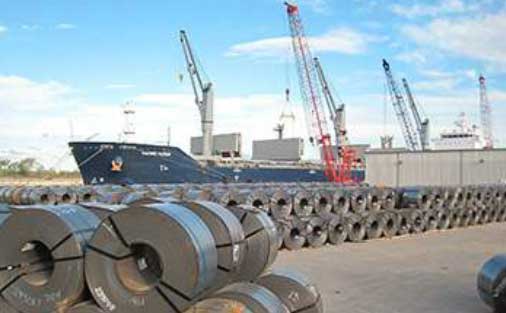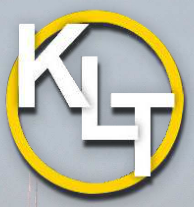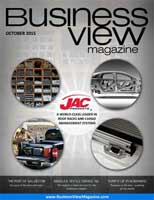Connecting the crossroads of america to the world
Indiana is in the heartland of the United States. Indianapolis, its capital, is 1,950 miles east of the port city of San Francisco on the Pacific Ocean, 645 miles west of the Port of New York, on the Atlantic, and 715 miles north of New Orleans, where the Mississippi River flows into the Gulf of Mexico. So when Jody Peacock, Vice President of the Ports of Indiana, admits that “some people don’t realize we have ports in Indiana, but, in fact, we have three,” it’s easy to understand the skepticism that many in the Hoosier State shared years ago when two visionary business leaders, George A. Nelson and Patrick W. Clifford, stood on the shoreline of Lake Michigan in 1932, and dreamed of building “a great public port” there.
For nearly 30 years, Nelson worked to make that dream a reality, and by the early 1960s, after the St. Lawrence Seaway had been completed in 1959 and waterborne commerce began to multiply on the now unobstructed corridor between Lake Michigan and the Atlantic, the political and financial stars finally aligned in Indiana. In 1961, the state legislature created the Indiana Port Commission (known today as the Ports of Indiana), a quasi-state enterprise with a governor-appointed, bipartisan board of directors. To then-Governor Matthew Welsh, the issue was clear-cut – he believed a Lake Michigan port was essential for the state. And in Washington, D.C., Congress passed the Rivers and Harbors Appropriations Act of 1965, which helped underwrite the cost of port construction.
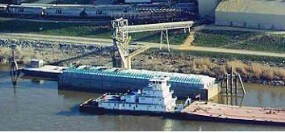 Today, the Ports of Indiana operates three public ports: the Port of Indiana-Burns Harbor, the Port of Indiana-Mount Vernon, and the Port of Indiana-Jeffersonville. “The state of Indiana has one of the most unique port systems anywhere in the country,” says Peacock. “Our ports are located on two different waterways that provide access to two separate coasts. We have one port on Lake Michigan which gives us direct ocean access through the Great Lakes and St. Lawrence Seaway to the Atlantic Ocean, and we have two ports on the Ohio River which connect to the Mississippi, down to the Gulf of Mexico. All three of our ports can access the inland river system which provides year-round barge shipping to over 20 states and allows for direct transfer with ocean vessels in the Gulf.”
Today, the Ports of Indiana operates three public ports: the Port of Indiana-Burns Harbor, the Port of Indiana-Mount Vernon, and the Port of Indiana-Jeffersonville. “The state of Indiana has one of the most unique port systems anywhere in the country,” says Peacock. “Our ports are located on two different waterways that provide access to two separate coasts. We have one port on Lake Michigan which gives us direct ocean access through the Great Lakes and St. Lawrence Seaway to the Atlantic Ocean, and we have two ports on the Ohio River which connect to the Mississippi, down to the Gulf of Mexico. All three of our ports can access the inland river system which provides year-round barge shipping to over 20 states and allows for direct transfer with ocean vessels in the Gulf.”
The Port of Indiana-Burns Harbor was Indiana’s first port. It opened in 1970, in Portage, on the southern tip of Lake Michigan. Home to 30 companies, it is one of the most modern of all the Great Lakes ports. Burns Harbor handles international ships, large lake vessels and river barges.
The Port of Indiana-Mount Vernon opened for business in 1976 on the banks of the Ohio River. Today, Mount Vernon is home to the seventh largest inland port district in the country. The port moves more cargo by water and rail than any other port in the state. Bulk cargoes such as grain, ethanol, DDGs, coal, fertilizer, cement, minerals, and project cargoes are shipped by port companies to and from 20 countries and 44 states. The port contains 1,200 acres of land and has 600 acres available for development, including a 500-acre mega site connected to the Ohio River and five Class I railroads.
The Port of Indiana-Jeffersonville began operations in 1985. It is located on the northern bank of the Ohio River, across from Louisville, Kentucky. With 1,057 acres of land and 3,200 feet of riverfront, Jeffersonville is accessible from all directions year-round via rail, road, and water. Jeffersonville is one of the Ohio River’s fastest growing ports and features the “Steel Campus,” a consortium of 12 steel-processing tenants.
Together, the three ports that comprise the Ports of Indiana system handle more than $1.5 billion in waterborne cargo per year and provide annual intermodal exchanges for 150 ships, 4,000 barges, 60,000 railcars and 600,000 trucks. Over the years, private companies have invested approximately $2 billion in distribution and manufacturing facilities at the ports, currently generating nearly $6.4 billion in annual economic impact to the state, while supporting over 51,000 direct and indirect jobs.
The mission of the Ports of Indiana is to develop and maintain a world-class port system that operates as an agile, strategically-driven, self-funded enterprise dedicated to growing Indiana’s economy. While some ports require ongoing subsidies to maintain their facilities, the Ports of Indiana does not use state or local tax dollars to fund operations or infrastructure investments.
Peacock describes the Port of Indiana’s operational status: “We are a quasi-governmental entity focused on maritime economic development but we do not receive any public funding to support that mission. We are completely self-funded by our operating revenues which come from leases and also the wharfage charges for handling cargo through the ports. We have approximately 70 companies located at our ports that lease property or have some sort of operating agreement with us and we invest 100 percent of our revenues back into developing and maintaining the ports – infrastructure, dock walls, sewers, rail, heavy-haul roads, maintenance and also in the purchase of land to expand our port system.”
Peacock goes on to describe the Ports of Indiana’s tenants and the cargo that passes through the system: “We have a group of world-class companies at our three ports. They operate processing and distribution facilities handling steel, coal, grain, fertilizer, project cargo, limestone, liquid bulk, ethanol, DDGs, and a wide range of industrial materials used in manufacturing and construction. Many of our port companies handle steel that is used in the automotive and appliance industries.”
Recently, the Port of Indiana-Burns Harbor has been handling multiple shipments of beer tanks for the craft brewing industry in Michigan and Illinois, as well as windmill components for Northwest Indiana, Illinois and Ohio.
“Our ports have become preferred destinations for large-scale project cargoes moving into the Midwest,” Peacock says. “We have handled a large volume of equipment for the construction and expansion of refineries, automakers, fuel processing, breweries, and power plants. Our ports are ideally positioned for companies that want to ship large dimensional cargoes into the Midwest by water, and avoid trucking them halfway across the country.”
Indiana’s state motto is “The 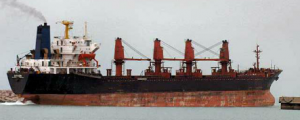 Crossroads of America,” and it’s the ability to connect multiple modes of transportation at the nation’s crossroads that helps give the Ports of Indiana a competitive advantage.
Crossroads of America,” and it’s the ability to connect multiple modes of transportation at the nation’s crossroads that helps give the Ports of Indiana a competitive advantage.
“It’s all about connections,” says Peacock. “All of our ports connect to multiple Class I railroads and are located within a day’s drive of over 75 percent of the U.S. market. Our Burns Harbor port has 16 different freight connections when you consider the eight rail carriers, five interstates, and the port’s three different maritime modes of transportation – ocean carriers, lake vessels, and river barges. Having this many options creates value for shippers in their ability to reach multiple regions and in the flexibility to change modes as needed to adjust to world markets.”
George Nelson was present at the dedication of Burns Harbor port in 1970, almost 40 years after he envisioned a public port on the shores of Lake Michigan. One wonders if he could have imagined the phenomenal growth that has taken place in the ensuing 40-plus years. Peacock elaborates: “We’ve seen a steady increase in economic activity and cargo shipments since the ports opened. In 2014, all three of our ports established new shipping records. Overall, the Ports of Indiana handled more than 10 million tons of cargo for the first time, and the 10.4 million tons was a 26 percent increase from the previous year.”
As successful as the Ports of Indiana has been, Peacock details an ambitious agenda for each part of the state’s system over the next several years. “Our bread and butter is attracting multi-modal companies to locate at our ports so they can leverage the waterways, rail connections, and port synergies to experience a long-term competitive advantage,” he explains. “In the last three years the Ports of Indiana has attracted roughly $150 million in investments from companies either opening new facilities or expanding their current facilities. For us, business attraction focuses on the companies at our ports and who their customers and suppliers are, and how we can help grow their businesses by bringing in new customers and suppliers. We have roughly 2,300 acres of land at our three ports, and of that, about 1,000 acres are available for development.”
Burns Harbor was first on the list: “This is our oldest port, located in the ‘Steel Capital of North America.’ It only has 85 acres left for development, but it has one the most prized pieces of real estate in all of the Great Lakes. We have a 57-acre plot of land on a working dock with onsite access for ships, barges and rail. It presents some tremendous opportunities for companies looking to launch new shipping ventures on the Great Lakes.”
The Jeffersonville port opened in 1985 and is the newest of Indiana’s ports, but it already has 28 companies and is in one of the fastest growing markets anywhere on the Inland Waterways System. A new interstate bridge over the Ohio River is being constructed about a mile from the port, which will make the port the first exit in Indiana when the project is completed in 2016.
“The bridge provides a new connection to Louisville and all points south that will create tremendous benefits for companies using the port,” Peacock says. “To put it in logistics terms, Atlanta will be 30 minutes closer; Lexington, Cincinnati, Nashville, Knoxville – all these destinations will be 30 to 45 minutes closer to the port. This is especially critical to many of the steel processors at the port that supply the automotive and appliance manufacturers in the region.”
The Jeffersonville port has 350 acres of land available for development and is partnering with regional stakeholders to construct a new heavy-haul corridor connecting the port to the 6,000-acre River Ridge Commerce Center.
“The heavy-haul corridor is being developed as a partnership between the local community, both facilities and the state in order to leverage the expansive development opportunities of the 6,000-acre industrial park with the port’s robust maritime and rail connections,” Peacock says. “This partnership will create one of the most unique large-scale industrial development opportunities in the country. Where else can you find a 6,000-acre site connected to 12,500 miles of waterways and multiple rail lines right at the crossroads of America?”
The Ports of Indiana is also poised for growth in the southwest corner of the state, and while the Port of Indiana-Mount Vernon is based in a small town, it serves a large multistate region and handles more cargo than Indiana’s other two ports combined.
“Mount Vernon is the seventh largest inland port district in the country,” says Peacock. “Our port handles large volumes of coal, steel, minerals, cement, and agricultural products. The port is also home to one of the largest ethanol plants in the Midwest, which is operated by Valero – the 10th largest company in the U.S. This is Valero’s first ethanol port on a river terminal anywhere in the country – this allows it to ship ethanol and DDGs on barges down to the Gulf or points along the way.”
The Mount Vernon port has a large footprint for future growth – roughly 600 acres available for development, most of it, recently-acquired land. In order to keep Indiana in play for major economic development projects of 500 acres or more, the port purchased nearby land to create a mega-site that is connected to port infrastructure.
“Mount Vernon has one of the only mega-sites on the Inland Waterways System that’s already connected to a working port,” says Peacock. “We have the dock, rail, and a terminal operator already in place. It’s essentially a ‘plug-and-play’ opportunity for a large-scale manufacturer or industrial facility. It can just plug into the port’s infrastructure and have immediate access to all the Ohio River barge lines and five Class I railroads, without having to build docks, railroad crossings or bridges into their facility.”
If there is any lingering skepticism about the wisdom of building ports in the state of Indiana, Peacock is ready to put that question to rest.
“There is a tremendous advantage for our port system to be able to handle maritime shipments over 600 miles from an ocean,” he says. “Our ports connect by water to two different coastal ranges – the Atlantic and the Gulf – and are located at the epicenter of the American heartland. Not only is Indiana home to the median center of the U.S. population, and but we’re also located at the intersection of all major rail lines and cross-country highways, and have direct access to two of the busiest inland waterways in the world. All of these features are key drivers for multimodal business development and growth in and around our ports. ”
In 1932, as Patrick Clifford and George Nelson were standing on that sandy beach in northwest Indiana, Clifford remarked, “There she is – Lake Michigan – pointed down into the heartland of the USA like a great finger into the bread basket of America. As sure as we stand here, a great public port will be built in this area. Maybe not in our time, but let’s see if we can make it happen.”
Today, thanks to visionary leaders, stalwart elected officials, farsighted businessmen, and sound leadership, the Ports of Indiana has certainly “made it happen.”
AT A GLANCE
WHO: The Ports of Indiana
WHAT: Operator of three maritime ports in Indiana on Lake Michigan and the Ohio River
WHERE: Central office in Indianapolis, Indiana
WEBSITE: www.portsofindiana.com
